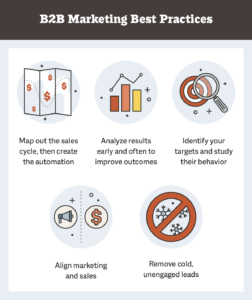If you’re a B2B business, you know how much there is to manage in the marketing and sales departments: content marketing and SEO for your blog, social media management to engage with customers directly, email campaign monitoring for leads, and customer relationships. B2B marketing automation exists to help businesses streamline all of these important aspects of their business so they’re able to move leads through the sales funnel quickly.
We work with many businesses to help with their automation so we’ve assembled the best practices you need to know to get started down the path of automation that leads to high-impact results for your business.
What is B2B marketing automation?
B2B marketing automation is a process of triggers and workflows businesses can leverage to streamline repetitive marketing and sales tasks and save time.
Nearly any stage of the sales funnel can be automated if done correctly, such as:
- sending marketing emails
- sales outreach
- finding new leads
- onboarding new clients
- publishing blogs
Setting up marketing automation helps businesses optimize their brand presence across every channel of customer engagement, allowing your sales teams to focus their resources to the leads that are most likely to convert.
In general, B2B marketing automation will use the following general structure:
Step 1: Create a list of potential leads to target.
Step 2: Execute an automated marketing campaign.
Step 3: Track how your potential customers react to the campaign.
Step 4: Organize your customers by their reactions.
Step 5: Send qualified leads directly to sales and route hot leads to a nurturing cycle.
Step 6: Monitor performance and redirect warm leads to sales immediately as they become qualified leads.
B2B marketing automation is usually done via software, but outsourcing some or all of your sales cycle is a great strategy to consider to help eliminate repetitive tasks so you can let your sales team focus on converting leads.
B2B marketing automation vs. B2C marketing automation
B2B and B2C marketing automation both involve using triggers and workflows to push leads through the sales funnel, but how this is achieved slightly differs.
In B2C marketing automation, the entire process is based on allocating marketing resources to personalization. For example, emails like cart reminders or promotions are sent to customers when they put an item in their cart but abandoned their purchase.
B2B marketing automation is focused more on sharing educational content with leads. Personalization is still important but is focused on the requirements of the customer. For example, if a customer signs up for a lead magnet, additional content may be sent to their email through email automation follow-up.
B2B marketing automation vs. CRM
In both sales and marketing, there are highly repetitive tasks, like onboarding a new self-service SaaS customer or sending promotional messages based on their behavior.
However, there are also very specific responsibilities that can only be handled by a human, which is how customer relationship management (CRM) differs from B2B marketing automation. While many of the goals overlap, you’ll need a combination of each to move the lead through the sales funnel.
Marketing Technology News: NFTz Becomes the Only On-Chain Social NFT Marketplace With All New User Experience
5 automation strategies to implement today
If you’re wondering where or how to start when it comes to B2B marketing automation, these five strategies will help position you for success.
1. Page-based triggers
Identify the specific behaviors leads engage in before becoming a customer. Maybe that’s visiting your pricing page, signing up for lead magnets, or interacting with you directly on your website via live chat. Whenever a lead engages in these behaviors, automate follow-ups so you can begin nurturing them immediately.
2. Educational content for new clients
If every customer onboarding process is typically the same, consider automating sending educational content after they sign up. Draft this content based on your FAQs that your customer support teams usually handle. Depending on the interests of your customers, send this content immediately after they sign up, or use an email drip campaign to avoid overwhelming them with information.
3. Nurturing leads
B2B marketing automation is ideal for nurturing leads. Share informative content with your leads through newsletters or other email campaigns to highlight your place as a thought leader within your industry.
4. Segmenting leads
As you collect data about potential customers, automatically segment them into different email marketing lists based on the type of activity, their level of engagement, location, and other characteristics. This step will save time and allow you to level up your lead nurturing program as each segment is personalized.
5. Qualifying leads
Most marketing automation software will qualify leads based on the configured requirements you set. Each action is assigned a point value, and when points reach a certain benchmark indicating they are close to becoming a customer, you can automatically transfer the lead to a different email list or send their information to a sales rep for follow-up.
The benefits of B2B marketing automation
B2B marketing automation can seem scary at first, but its impact on your bottom line and customer experience will make it worthwhile for your business.
1. Boost lead intake
Lead intake can be overwhelming if someone is responsible for the intake, nurturing, qualification, transferring, and more. By automating some of this process, you’ll avoid bottlenecks and lapses within the sales funnel.
2. Increase conversions (and therefore revenue)
Once lead nurturing and scoring are automated, your team will reduce the amount of time spent on bad leads and tedious back and forth. You’ll know exactly who to target and how, leading to increased conversions that happen faster.
3. Improve customer experience
By automating your calls to a 24/7 virtual receptionist service, your customers will get the answers they need quickly at any time of the day without feeling hurried by a sales rep who has other calls to handle, specifically sales calls.
4. Easily scale marketing campaigns
By removing the repetitive and time-consuming steps of marketing, your business will be more equipped to scale campaigns or make adjustments on the fly based on feedback from leads.
5. Control marketing spending
Because marketing automation makes you more efficient, you’ll have a better grasp of your marketing spend and gain insightful data that helps you make better marketing decisions. As a result, you’ll have better control over your marketing spending.
 Marketing Technology News: MarTech Interview With Curt Larson, Chief Product Officer at Sharethrough
Marketing Technology News: MarTech Interview With Curt Larson, Chief Product Officer at Sharethrough
Best practices to add value to your marketing automation
Specific automation strategies vary based on your industry, customer needs, key performance indicators (KPIs), and business size. However, they all have a few best practices in common.
1. Identify your targets and study their behavior
It doesn’t matter how amazing your marketing automation strategy is if you miss the mark with your target prospects, so it’s important to start with quality market research. Identify the leads you’re interested in targeting and organize them into specific groups.
Once you’ve sorted your leads into groups, study their marketing behavior:
- When is the ideal time to send an email?
- What types of content do they value?
- What encourages a purchase?
- What channel of communication do they prefer?
- How long does it take to make a purchase?
- How many people are involved in making a purchase?
- What pain points are involved in the purchase process, and how can you address them proactively?
2. Sales and marketing alignment
Like B2B sales outsourcing, you need to make sure your sales and marketing departments are in alignment before implementing any marketing automation. When marketing is automated, leads are sent directly to sals, sometimes without any need for human intervention. It’s important for sales teams to understand why leads are being sent to them so they understand what each lead is looking for before outreach.
3. Map out the sales cycle, then create the automation
Once you identify your targets’ marketing behavior, map out the sales cycle from start to finish for each specific group, and then develop an automation strategy for each.
The more detailed your understanding of the sales cycle for each of these groups, the more accurate your strategy will be. Subtle tweaks are much easier to make than complex changes if you learn your leads behave differently than what you anticipated.
4. Use reports and data to constantly improve
When you hear the word “automation,” it’s tempting to assume you can just set it and walk away under the belief your work is done, but that’s not the case with marketing automation. Most marketing automation strategies, whether it’s software or an outsource partner, will generate useful data you should use to improve your marketing and sales processes.
Marketing Technology News: Top 7 B2B Marketing Trends: What B2B Marketers Need to Focus On











